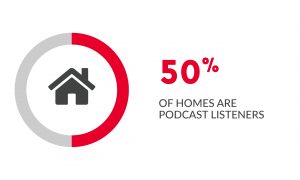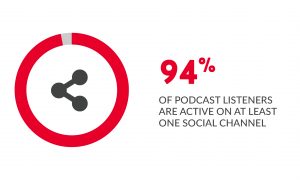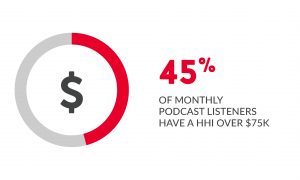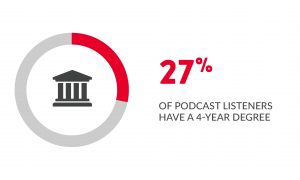If you’re looking to explore new avenues to expand your reach—and the depth of affinity—podcasting may be the perfect channel for you.
Did you know:
- 48 million people listen to podcasts weekly and 16 million are “avid podcast fans”
- They’re more likely to follow companies and brands
- They are more likely to subscribe to Netflix or Amazon Prime
- 80% of listeners listen to all or most of each episode


And, on top of that, podcast listeners are more likely to have a 4-year degree or higher, plus have a higher household income than non-listeners.


So, what does all of that mean for your brand? It means a highly-educated, loyal audience that, more often than not, is using streaming services and doesn’t see TV ads at all. They are active in social media and are willing to interact with brands in that space. And, once they start listening, they stick around.
Sponsoring popular podcasts by buying ads can certainly be a start. And the short ad breaks that are typical of podcast, as opposed to longer breaks on TV that people fast-forward through, can be very advantageous. But creating a podcast for your brand is the ultimate use of the form, allowing you to weave your messaging throughout and build that highly sought-after emotional connection with your target audience.
Who is my audience?
Like any other media buy, podcasting should be targeted, although the target can be broader. If your company manufactures camping equipment, for example, your podcast audience is the same as your media audience, but not always as segmented—maybe it’s a combination of backpacking Millennials, car-camping Gen X-ers and cabin-owning Baby Boomers. But what they all have in common is a love of camping and the outdoors. It can be wise, however, to use your demographic insights for a narrower audience; creating a podcast specifically about backpacking may not capture the breadth of your target, but can build a high affinity for your brand with Millennials, a segment that you are hoping to grow.
What do they want?
People seemingly come to podcasts for two reasons: information and escape. If you take a look at the weekly ranking of podcasts on Stitcher, you can group each one into one of these two categories, or both.
Information includes news, self-help and business shows. But it also includes a slew of other podcasts that inform listeners on topics that interest them, such as music, literature and travel. Informational podcasts don’t have to be dry—Rolling Stone Music Now is a great podcast that features both interviews with famous musicians and expert commentary from the Rolling Stone staff. Education and news are the second and third most popular genres, respectively.
Other podcasts are an escape from your daily life—an opportunity to zone out and enjoy while you’re driving or doing the laundry. This includes much of the comedy genre, which is also the most popular. Fiction podcasts like Selected Shorts from PRI, or the New Yorker fiction and writer’s voice, give listeners a chance to experience literary fiction performed by great actors and writers. Popular true crime podcasts, such as Up and Vanished, although non-fiction, are more about getting lost in a story than they are about learning.
Some podcasts, like Slate’s Slow Burn, offer a combination of information and escape from your daily life. Each season of this podcast focuses on one historic event, such as the Watergate scandal, and combines in-depth interviews with historic recordings and other tapes to create an engrossing deep-dive into history. Lore is another podcast that brings true stories to life through superb storytelling.
Where do brands fit in?
At the time of this post, the third most popular podcast on iTunes was Spit, an iHeartRadio podcast created by genetic testing company 23andMe. By using a popular and well-known host, Baratunde Thurston, the podcast has instant affinity. But what’s particularly interesting is how they relate it to their brand: Thurston interviews famous “cultural influencers” like Wyclef Jean and Melissa Etheridge about “how DNA testing gives us a new perspective on who we are and how we are all connected.” Here, 23andMe builds on the popularity of Thurston and his celebrity friends, and a respect for their opinions, to create an emotional connection with DNA testing. On the first podcast, John Legend talks about researching his family history, and what he’s learned through DNA testing. It instantly makes the listener want to learn more about themselves through genetic testing, and 23andMe is right there to help.
You don’t have to have a celebrity host, although it really does help and a lot of brands go in that direction. Sephora partnered with GirlBoss media to create the #LIPSTORIES podcast, leveraging the existing skills and audience of an established podcast creator. REI doesn’t use celebrities at all for either of their branded podcasts—their hosts are just the people producing the shows.
Okay, I’m sold. Now what?
You’ve tackled the two biggest questions: What is your audience and what is their need? What comes next is deciding the theme of your podcast and the format. Sticking with Millennial backpackers, maybe the theme is budget backpacking around the world. Is it going to be an interview show? Are you going to send a producer around the world? A crew? Determining a ballpark budget and estimating what you need can help you determine the scope of what you choose to do. Of course, you can do these things yourself, or you can partner with an agency like ours that can help handle creative and production and scale up or down, depending on your needs.
Data: Infinite Dial 18, Nielsen Aug 2017 and Q1 2018
